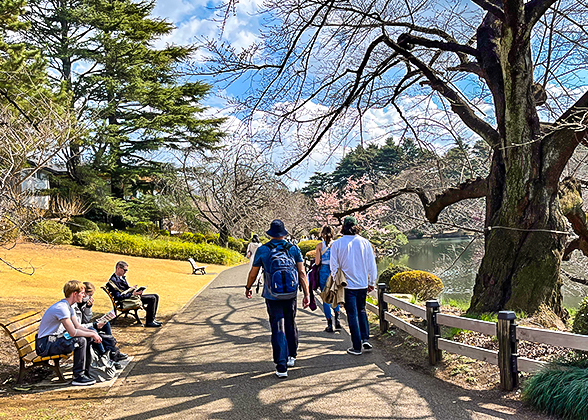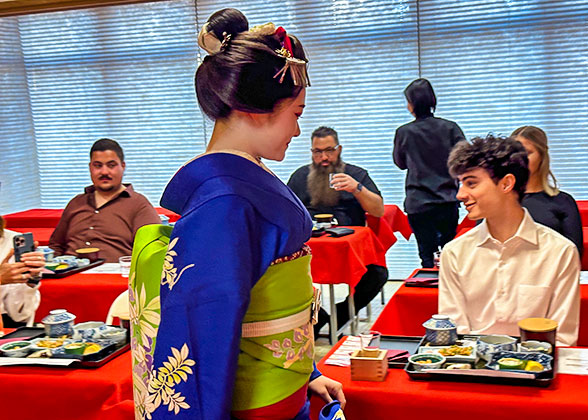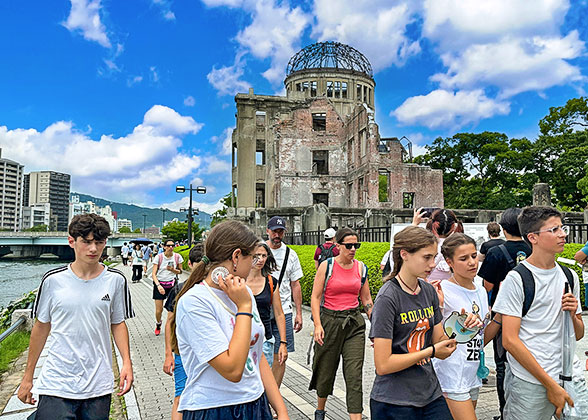Shinjuku Gyoen National Garden
Shinjuku Gyoen National Garden in the center of Shinjuku, Tokyo was the royal court in the past. Nowadays, it is open to the public, attracting both foreign visitors and local residents. The park contains three main gardens that reflect different garden styles, namely the French Formal Garden, the English Landscape Garden, and the Japanese Traditional Garden. It is one of the best places to appreciate cherry blossoms in Tokyo, because it has more than 800 cherry trees of 80 species. March and April are the best time to see cherry blossoms. In general, half a day is enough for visitor to view the garden.
|
|
|
Three Main Gardens of Shinjuku Gyoen National Garden
1. Japanese Traditional Garden
The Japanese garden is a part of the original landscape of Shinjuku Gyoen, with large garden pools dotted with islands and bridges. Besides, the old imperial pavilion established in 1927, known as Taiwan Pavilion has been a landmark there. The pavilion was donated by the Japanese living in Taiwan in order to celebrate Emperor Showa's wedding, reflecting pure Chinese architectural style.

Taiwan Pavilion in Gyoen
|
2. English Landscape Garden
English Landscape Garden is made up of a large grassy area and a large cluster of huge trees. Standing on the grass and looking out into the distance, you can see the tall buildings of Tokyo. During sunny days, it is common to see many people having picnics here. Besides, there is an Old Imperial Rest House with a western style that was established in 1896, and it was listed as a cultural property of Japan in 2001.3. French Formal Garden
French Formal Garden, also known as Geometric Garden, owns a big rose bed. Mid-November is the best time to appreciate these fall roses. The plenty of sycamore trees creates a movie-like scene, attracting many photographers to come here in the autumn to take photos of the flaming leaves.Other Things You Can Do Here
1. Appreciate Different Seasonal Scenery
Different celebrations will be held in Gyoen in different seasons, which generally takes seven days for each celebration. During the cherry blossom season in spring, you can appreciate varied cherry trees, like Winter cherry blossoms, Someiyoshino cherry blossoms, and Sekiyama cherry blossoms. Viewing the plenty of red maple leaves here in fall also is an enjoyable thing. Besides, the Chrysanthemum Exhibition in the fall allows you to appreciate different types of chrysanthemums; it is held from Nov 1 to Nov 15.

Cherry Blossoms in Spring
|
2. See Tropical and Subtropical Plants
There is an old Western-style greenhouse that was built in the 19th century and is close to the Okido Gate. The greenhouse is divided into a Pond area, tropical area, subtropical area, and desert area. You can find 2,400 tropical and subtropical plants. Besides, you can appreciate diverse orchids, huge trees, and waterfall inside.
|
|
|
3. Explore Spot from Animated Movie “The Garden of Words”
“The Garden of Words” was directed by the famous director Makoto Shinkai in 2013. In the animated movie, the old imperial pavilion from Gyoen is a key spot. If you are a fan of Makoto Shinkai, snapping a picture is a good choice.4. Have a Rest in the On-site Restaurant, Cafe, and Tea Room
Gyoen provides varied facilities for visitors to relax. Eco-House Restaurant YURINOKI is close to Shinjuku Gate, and it provides some food related to Gyoen. You also can know about the knowledge about the seasons, history, and usage of food material in the area of Food information. Rakuutei is a tea room with a traditional Japanese style, providing green tea with Japanese sweel. You can taste authentic Japanese matcha and dessert. Each matcha costs 700 yen. Besides, Cafe HANANOKi provides diverse café, drinks, desserts, and curry rice.How to Get to Shinjuku Gyoen National Garden:
Shinjuku Gyoen has three entrances, namely Shinjuku Gate, Okido Gate, and Sendagaya Gate. The Shinjuku Gate is used by the majority of visitors.
Shinjuku Gyoen Gate is easily reached by walk from JR Shinjuku Station, Chuo Main Railway Line Sendagaya Station, or Tokyo Metro Shinjuku-gyoemmae Station.
Ticket Price:

The Grassland in Gyoen National Garden
|
Opening Hours:
From March 15 to June 30 and August 21 to September 30, it opens from 9:00 to 18:00;From July 1 to August 20, it opens from 9:00 to 19:00;
From October 1 to March 14, it opens from 9:00 to 16:30.
* Admission ends 30 minutes before closing.
* It is closed on Mondays, except March 25 to April 24 during cherry blossom season; and from December 29 to January 3.
* Electronic admission tickets can be purchased in advance from the official website.
Tips:
* Reservations are required to enter the garden during the cherry blossom season.* It is forbidden to drink alcohol, use sports equipment, or play musical instruments inside the garden.
Nearby Attractions:
Hanazono Shrine is another oasis in Shinjuku. On weekends you can find many vendors around the shrine selling antiques, prints, crafts, and kimonos. The bright lanterns create a beautiful night view. It takes about 17 minutes to walk there from Shinjuku Gate of Shinjuku Gyoen National Garden. Besides, Tokyo Metropolitan Government Building is a a City Hall Complex, of which the highest point is 243 meters (797 ft.). From its observatories you can get a view of the whole city. You may take the subway Oedo Line from Kokuritsu-Kyogijo Station and get off at Tochomae Station to reach it, which costs 180 JPY.
Shinjuku Gyoen National Garden Photos & more Tokyo Photos





